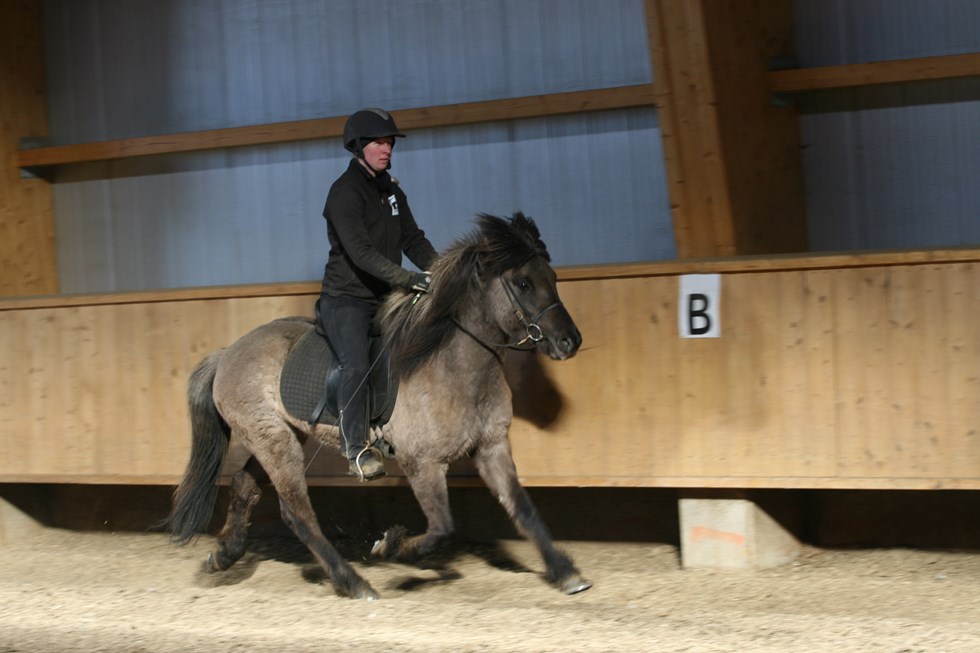
Starting young horses
One of the services available at Urvalshestar is starting young horses. On this page you can read about our ideas and methods on how we start horses. We use many techniques from behavior modification, because initial training of the horse is, of course, exactly that. The horse is mostly learning “manners” in the beginning, and those are all new behaviors. Later, the subjects gradually become more physically oriented, i.e. more about making the horse fit as far as endurance, strength and flexility.
.jpg?maxwidth=980)

Goals and progress
The progress in the training depends for the most part on how well the horse was prepared when it came, what its temperament is like, and of course how long it stays in the training. The goal is that the horse learns the following subjects:
- To be caught
- To be led by hand
- To stand still while mounted and dismounted
- To carry a bridle and saddle
- To stand tied
- To free school
- To be shod
- To be ridden in walk, trot, and canter inside and outside, and perform simple transitions between those gaits
Other tasks that are often taught and then according to wishes of the owner:
- To be a handhorse with another horse
- To be lunged
- Other special wishes on the owner´s behalf
The primary goal is always mutual trust and respect when working with the horse. The relationship between man and horse needs to be fearless from both sides for any education to take place. The speed of progress depends on how long it takes for the trainer to earn that trust from the horse, because then we can start to teach the horse new behaviors.
Some horses have never been handled before they are four or five years old, and in those cases they are often very hot and/or fearful. Then we usually have a period of time, which can be quite long in difficult cases, during which the horse is not ready to learn anything new. All that is possible to work on is to get rid of that fear and make the horse more confident in the new surroundings. Some horses, however, have been handled before this training start, i.e. before they reach this age. Those horses learn much faster than the unhandled horses, plus they don´t have the fear baggage to carry in the beginning. You can read about what we offer on young horse handling under Handling and evaluation of youngsters here on the left.
Click here to read about young horse handling and evaluation
When we work with the fearful horse, it is important to stay outside his personal space because then he is not scared anymore. The personal space is a space around every horse, bigger the more scared he is. It is marked by an imaginary line around him, and decreases in size as the horse becomes less fearful. To be able to work outside his personal space, we have to use a roundpen or long reins to have control without holding the horse. We don´t want to make the horse tolerate us, it does not make them less fearful, and therefore, the whole process takes longer time. Having the choice of leaving is what makes the horse trust the human being, and the training is about getting the horse to choose to stay with us.
The first thing done with all new horses is to put a halter on them. We do have to intrude into the horse´s personal space in that process, but there is just no way around that. Then we hook a long rein to the halter and take him to a space that is big enough that the horse can move around to get us out of his space. Then he will be calm enough to learn something, and the first thing we do is to teach him to understand and obey the rein. As the horse becomes less fearful he will allow us closer and closer to him, and when the personal space has disappeared we can teach the horse all those things that horses need to learn to become riding horses, such as carrying the bridle, the saddle, and eventually the rider.
What we emphasize teaching horses that come here to be started is the following:
- To respect the man as his leader
- To be caught and lead
- To carry the bridle
- To carry the saddle
- To let the man get on and off
- To tie
- To be shoed
- To be ridden in walk, trot and canter
- To be ponied from another horse
.jpg?maxwidth=980)
Depending on how long the training period is and the talent of the horse, we start to ride tolt. At this point the horse has been started and more emphasis is put on physical training which is general fitness training, and making the horse better at doing things that he already knows. You can read about that under advanced training here on the left.
Click here to read about more advanced training
Feel welcome to contact us about starting your horse anytime.